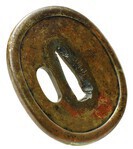陸軍恤兵部派遣 日本ポリドール慰問団
Rikugun Juppei-bu Haken Nippon Polydor Imondan
or
Army Relief Group (Sponsored) Nippon Polydor Comfort Corps
Imon is consolation, but in this case we think relief or comfort. This is, as I said tongue in cheek earlier, most likely a group of recording artists who toured around to give relief/recreation to the troops, like our USO. I expect as has been suggested that the officers are in charge of whatever base they were at, though this almost looks like they posed after surrender they look so dour.
Tip of the hat to Colonel Creswell for his invaluable assistance...
-t


